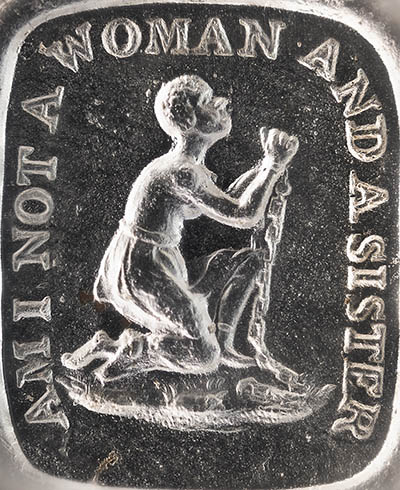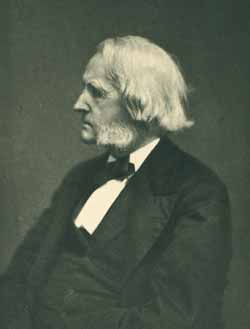
This website presents digital images of 840 visual materials from the collections of the Massachusetts Historical Society that illustrate the role of Massachusetts in the national debate over slavery. Included are photographs, paintings, sculptures, engravings, artifacts, banners, and broadsides that were central to the debate and the formation of the antislavery movement.
Massachusetts (and Boston in particular), the home of antislavery abolitionist William Lloyd Garrison and the Liberator, became known world-wide as the nexus for the American antislavery movement. Images of the key players; broadsides and banners announcing antislavery meetings and fairs; and visual imagery of the movement as seen through patriotic covers, political cartoons, and artifacts showing the horrors of slavery are key to understanding how the movement was communicated and followed.
The majority of images presented within this digital collection are portraits and sculptures of men and women who participated in the debate about slavery. Included are formal oil portraits of John Albion Andrew, governor of Massachusetts from 1857-1866, and Wendell Phillips, a prominent lawyer and skillful orator; and marble busts of Charles Sumner, a lawyer and senator who supported emancipation, and William Lloyd Garrison. Also available are digitized versions of the 742 items within the collection, Portraits of American Abolitionists, 1850-1890. These photographs, tintypes, engravings, lithographs and photomechanical reproductions depict supporters and opponents of slavery primarily from the United States and Great Britain.
 Great Is Truth! Great Is Liberty!..., Garrison antislavery banner
Great Is Truth! Great Is Liberty!..., Garrison antislavery banner
 Great Anti-Slavery Meetings!
Great Anti-Slavery Meetings!
 First Anniversary of the Kidnapping of Thomas Sims, by the City of Boston
First Anniversary of the Kidnapping of Thomas Sims, by the City of Boston
These portraits, collected by Francis Jackson Garrison while working on an extensive biography of his father, William Lloyd Garrison, 1809-1879: The Story of His Life Told by His Children, (New York: The Century Company, 1885-1889), depict the key individuals in the slavery debate--images of men and women who supported a range of solutions including colonization, a gradual end to slavery, or full and immediate emancipation. In the introduction to his book, Francis Jackson Garrison wrote, "that posterity ought also to have the opportunity and the privilege of seeing the faces of the less conspicuous, but not less essential, workers in the great cause."
The banners and broadsides presented here convey the themes, sentiments, and spirit of antislavery events in Massachusetts. Banners used by the Massachusetts Anti-Slavery Society at antislavery meetings and parades state strong messages such as "Proclaim Liberty Throughout the Land, Unto All the Inhabitants Thereof" and "Our Fanaticism! All Men are Created Equal: Thou Shalt Love thy Neighbor as Thyself." Broadsides advertise antislavery meetings (for example, Great Anti-slavery Meetings), convey information supportive of the abolitionist cause (for example, Comparison of Products, Population, and Resources of the Free and Slave States), and spotlight key cases involving freedom seekers including Thomas Sims (The First Anniversary of the Kidnapping of Thomas Sims ...) and George Latimer(Great Massachusetts Petition). Some of the broadsides contain many lines of dense text, a common practice for this form of communication and a reminder of the considerable role the printed word played in creating an antislavery sentiment throughout nineteenth-century America.
Other materials that convey the activities of Massachusetts abolitionist groups are tickets to various events (for example, ticket to 1857 Massachusetts Anti-Slavery Society event) and antislavery wafers--printed antislavery slogans that could be detached and used to seal or close envelopes. An extra large manuscript figure, "Diagram to show the drill the Anti-Man League had for the running off of a slave or man-hunter," conveys the plan developed by a secret society in Boston founded to resist the Fugitive Slave Law.
Some materials featured online are examples of propaganda with gripping illustrations conveying the cruelty of enslavement and/or images promoting abolition. The engraving, Scene on the Coast of Africa shows enslavers' brutal treatment of Africans. Patriotic covers (envelopes featuring images and slogans) were a format employed by both Unionists and Confederates to promote their causes during the Civil War. The examples featured within this digital collection (including "We is de innocent root ob dis yere trouble ..." and I' m Glad I'm not in Dixie! ... ) all promote the Union cause and decry slavery but frequently express abolitionist sympathy through racial prejudice and stereotype.
 Governor John Albion Andrew
Governor John Albion Andrew
 William Lloyd Garrison
William Lloyd Garrison
 George Latimer
George Latimer
 Am I Not A Woman And A Sister
Am I Not A Woman And A Sister
 Lucy Stone
Lucy Stone
 Samuel Edmund Sewall
Samuel Edmund Sewall
Artifacts depicted here include some collected by Governor John A. Andrew to convey the horrors of slavery (slave collar and whips used on African Americans). Also available are images of billy clubs used to protect William Lloyd Garrison from mob-incited violence and an embossing seal with the inscription, "Am I not a Woman and A Sister."
To access the digital representations of the featured materials relating to the antislavery movement please refer to the browse by format list. Researchers using the Massachusetts Historical Society's online catalog, ABIGAIL, will find links to web displays from within specific bibliographic records for the featured items. Also, the online collection guide to the Portraits of American Abolitionists collection includes links to the digitized displays of all of the 742 portraits (engravings and photographs) of individuals involved in the antislavery debate.
Be advised that some of the items in this feature contain racist descriptions and imagery.
Funding for this website and digitization project was provided by the Institute of Museum and Library Services under the provisions of the Library Services and Technology Act grant as administered by the Massachusetts Board of Library Commissioners.